Here we re-tell the Huichol creation myth of Takutzi Nakawe, Grandmother Rain, and how the world was created, according to as they are known the Wixaritari (Huichol) of the Western Sierra Madre Mountains of Mexico.
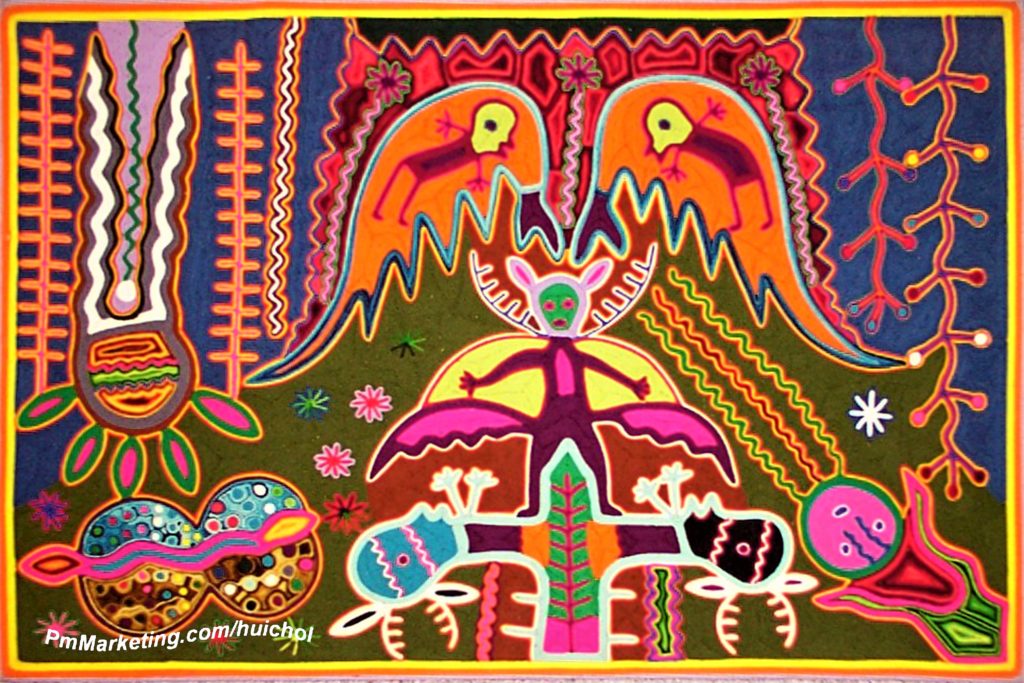

Huichol Cosmovision: The Place Where It Begins
Traditional Story from the Wixaritari, Based on the Animated Version Written by Julio Parra (Ma`arakame), Edited By Jack Eidt
Watacame, the first human, journeys with Takutzi Nakawe (Grandmother Rain), in a story about those who walked the Earth to found the creation of life and the blooming of sustenance into the present era. Grandmother Rain recommends Watacame construct a raft made of chalate wood to withstand five days of monsoons, wind, waves, flooding, and storming.
Into the swirling tempest, Watacame and his black female dog Tziku Mayuri spun round and round in the waves. Would the downpour ever end? The Earth was covered in an endless sea. Watacame looked to the clouds, prayed, dreamed, and held on to the raft and his dog. Looking up to the sky, he saw the clouds part, and Grandmother Rain came down.
Five days of storming suddenly ended. The number five, a sacred number correlating to the Five Suns of the Aztec calendar and also the Four Directions and the Center, appears regularly in the Huichol cosmovision. The Goddess then struck her staff five times on the raft, and they transformed onto dry land.
STORY: Wixárika/Huichol People: Protecting Sacred Lands of Mexico
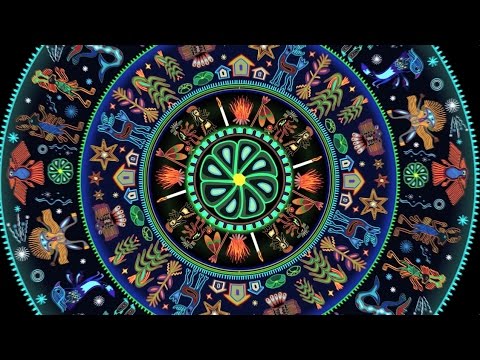
Watch this video on YouTube
The Huichol Cosmovision Creation Story Takutzi Nakawe (Grandmother Rain) (Español, English Subtitles)
Grandmother Rain unleashed what she calls gods, which means a soul, a species, an essence, an impulse. These gods and forces must come to fulfill their calling, sent to seek their respective sacred places, to manifest in the land, to make distinct the landscape.
A god or a force whose living existence connects to sacred space, cultivates health, knowledge, beauty, and inspiration in all the life within its sphere. Thus, Watacame walked with gods and forces of the World, guided by Grandmother Rain, seeking to bring to life the sacred lands that the Huichol people would one day worship and protect.
Walking beyond time, as the concept had not yet been created, they heard a sonorous chant from the primordial darkness. This singing carried a certain harmony bringing light and hope to the blackened world. The chant emanated from what might be called a sacred temple of the gods. The elder brother Blue Deer, Tamatzika Kuyumare, offered to guide Watacame to the other side of the snake-shaped river. There, they would be welcomed into the revered land-temple.
STORY: Peyote Guardians: The Huichol Struggle of Life and Spirit
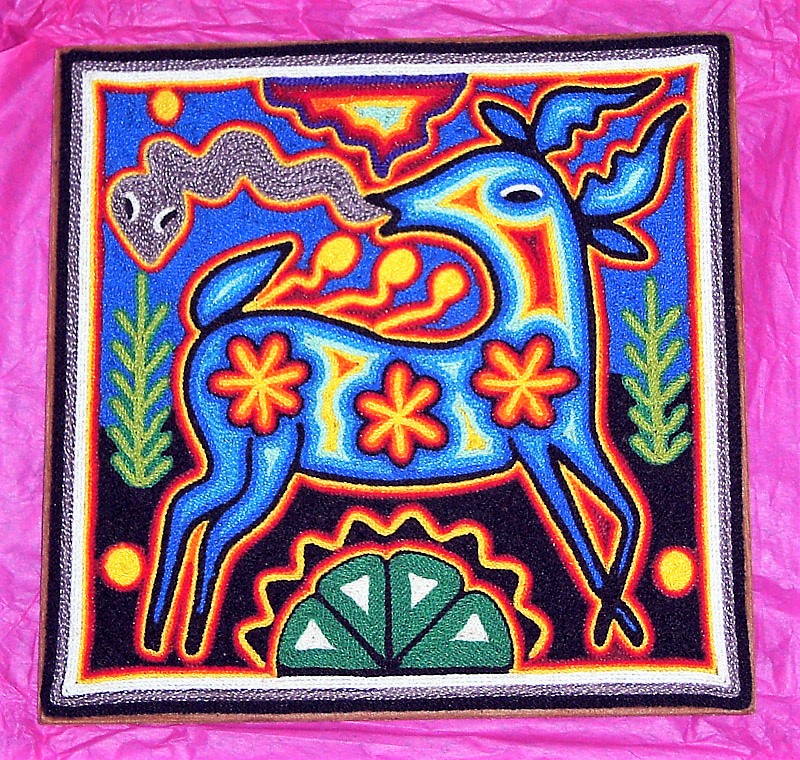

So the gods on pilgrimage arrived at the serpentine river called Waiwerie. The Blue Deer invoked another of the gods to shoot his arrow into the land across the river. When the arrow landed, the landscape illuminated the territory called Pariyatze Wirikuta, the sacred temple of the gods. And the gods and forces then transformed into mountains, rocks, rivers, caves, forming into sacred places. From the light, all life grows and thrives, and some of the gods and forces understood they must press on to discover the source of Wirikuta’s brilliance.
Forward on the journey, they encountered Tatutzi Uxainuri, Grandfather Fire. Watacame asked, “Grandfather, are you the light for which we seek?” Despite his brightness, he admitted he could never claim to illuminate the world. He commanded them to search for a left-handed child, who will give life to the sun. Another of the gods added they must ask permission from the boy’s mother.
When they found the boy, some of the gods and forces didn’t believe that this curiously glowing left-handed child knew the light of the world. The owl god, however saw in him the power, and the boy confirmed they were correct, already recognizing his own destiny. To his mother’s dismay, he left with the pilgrims.
When presented before Grandfather Fire, the left-handed child guided him through a brief dance saluting the four cardinal points. He played a hoop and arrow game in which he struck his hoop with an arrow causing it to roll along the ground, thus raising much smoke and dust, the origin of human diseases and epidemics. To counteract this evil, the Blue Deer advised the gods to place five prayer arrows in each hole where the earth had caved in. This enabled the control of diseases to some extent.
Soon, the left-handed boy entered the fire and it slowly extinguished. Some of the gods and forces grew worried and agitated, claiming the boy was a trick to kill all light. Yet, soon from behind the Quemado Mountain, the sun rose for the first time. The doubting gods turned to stone before the rising sun.
STORY: Pamparios: A Trip with the Huicholes to Collect Peyote
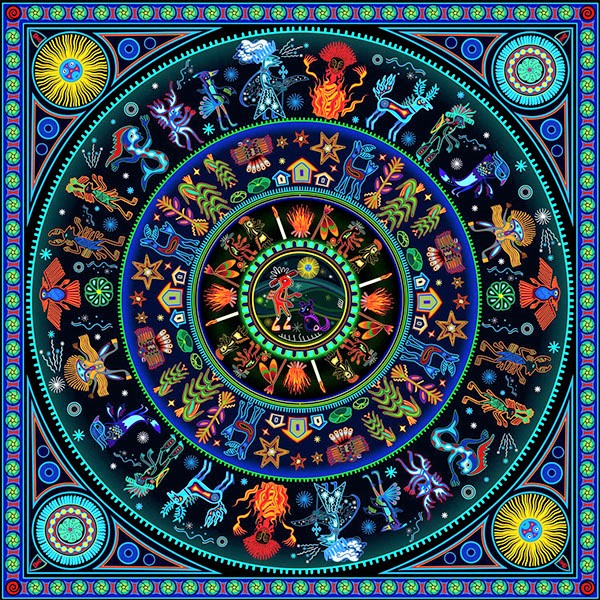

The gods and forces considered naming the boy, such as “He of the Feathered Sombrero,” or “He of the Crown of Arrows,” but none seemed quite right.
Moreover, the sun was too close to the Earth and so the snake people grew wings so they might fly up into the sky and eat up the sun.
In defense, the sun established red, blue, and gray stars in the sky, and the snake people failed.
In desperation, the gods went up onto a high mountain, where a quail and a turkey appeared — in those days animals were really people. The turkey person raised his head and said “aru, aru, aru,” but nothing happened. The second time he said “tau-tau-tau” and more light appeared.
Finally, messengers were sent to ask Grandmother Nakawe to raise the sun up higher so that it would not harm the people. They took a further pilgrimage with the Rain Goddess and continued singing all the way — the very songs the Huichols sing to this day.
Finally, Nakawe pointed her mumuxi (staff) in all the cardinal directions and the center exhorting them to assist in raising up and supporting the sun. Five times she raised the sun and then asked the gods where they wanted it. At the fifth raising, she left the sun where it is today.
“Stay at this height forever,” Nakawe told the sun. She fastened it in place with pine tree trunks. That is why the Huichols, in commemoration of the tree of our Father Sun, still use pine trees to support the roof of the calihuey, the god house in the ceremonial centers.
STORY: La Loba: Wild Woman, Luminous Wolf
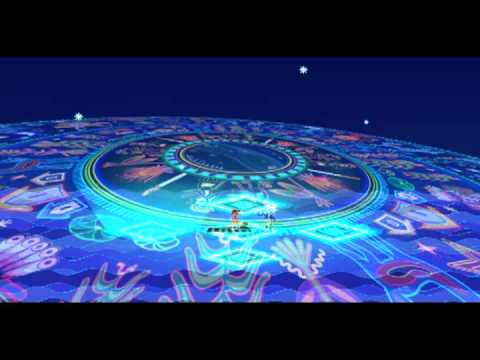
Watch this video on YouTube
Grandmother Rain – A trailer in Wixarika, with Spanish and English subtitles
Soon it illuminated the entire planet, fertilizing the seed of life, giving birth to all the animal and plant species that inhabit the earth.
At last the magical boy received his name: Tawexikia and Tayeu (The Sphere of Great Rays, our Elder Brother), as Father Sun is called today. From that time on the people began to live happily in his light.
Once the sun had fully risen, Tziku Mayuwi, Watacame’s black female dog companion, transformed into the first woman, completing the couple for good. Once the pilgrimage concluded, Grandmother Nakawe told Watacame to cherish and honor the sacred places where the gods stayed, this way these places would bring equilibrium and health to the entire creation.
STORY: Yaqui of Mexico: How the Sorcerer Cricket Saved the People
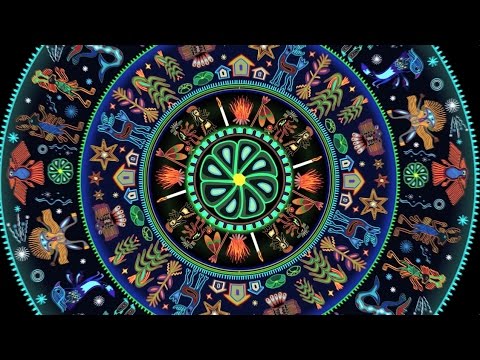
Watch this video on YouTube
Directed By
Jose Matiella
Written By
Julio Parra (Ma`arakame)
Screenplay By
Aaron Pankowsky con revisiones de Jose Matiella (basado en 13 cuentos Huicholes)
Produced By
Jose Matiella
Sources
Updated 3 March 2023



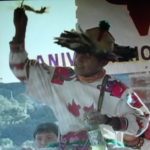
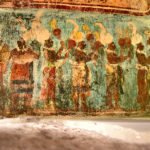
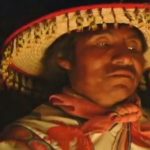
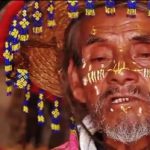






This was absolutely lovely. I hope to find more of these ancient stories animated in the near future. They inspire a feeling that is pure and simple but easily forgotten. Thank you all for being such blessed reminders of this emotion. Ciao!
Pingback: Ch´ol Creation Story: The Origin of Life on Earth
Pingback: Virgin of Guadalupe: The Apparitions of An Aztec Goddess
Pingback: Pamparios: A Trip with the Huicholes to Collect Peyote
Pingback: Wixárika/Huichol People: Protecting Sacred Lands of Mexico
Pingback: Popol Vuh: The Maya Creation Myth Unveiled - WilderUtopia